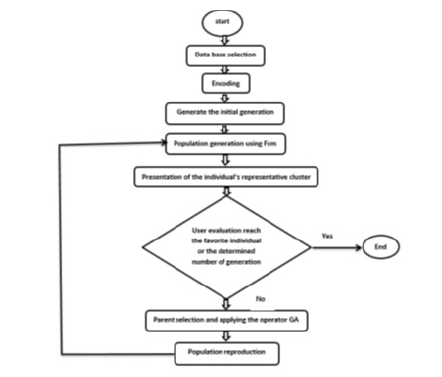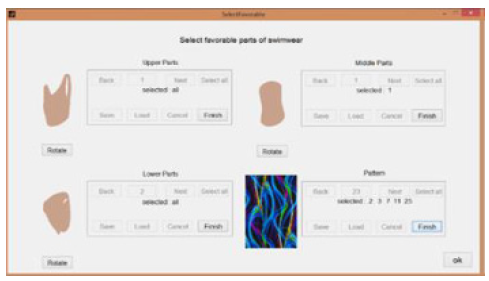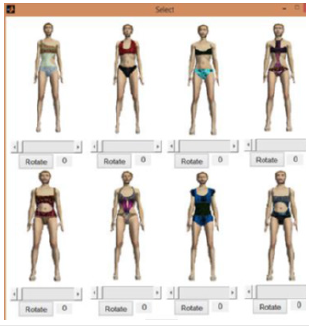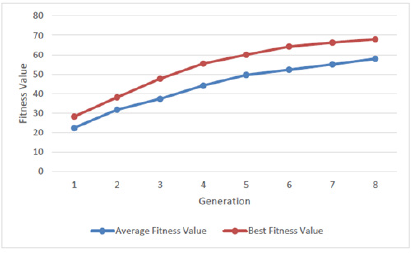- Submissions

Full Text
Trends in Textile Engineering & Fashion Technology
3D Garment Design using Interactive Genetic Algorithm and Clustering
Zarezade T and Payvandy P*
Department of Textile Engineering, Iran
*Corresponding author:Payvandy P, Department of Textile Engineering, Yazd University, Iran
Submission: March 06, 2019;Published: May 06, 2019

ISSN 2578-0271 Volume5 Issue1
Abstract
Today, the use of computers in fashion design has become a special place. In this research, the 3D design of clothing is presented using an interactive genetic algorithm (IGA) and fuzzy clustering method (FCM). To reduce user fatigue, it is possible to select the database parts by the user, which leads the initial generation according to user’s interests. Using the genetic algorithm, garment designs are created. garment designs are placed on the dummy, and with the dummy rotating, all parts of the dress are visible to the user. In this study, FCM methods of clustering are proposed in order to reduce user fatigue. The user only evaluated the representative individual’s fitness for each cluster and the fitness of other individual are estimated according to the level of similarity and the representative’s fitness. 3D designs of women’s swimsuit are used as a database to illustrate the performance of IGA fashion design system. The results show that the use of IGA and FCM are effective in designing 3D women’s swimsuit, and positive results can be seen on the user’s fatigue reduction. It also shows that the satisfaction of this system is high and can facilitate the design and promotion of its level and help designers.
Keywords:User fatigue; IGA; Data mining; FCM; 3D garment design
Introduction
IGA is one of these intelligent systems that have ability using in fashion design. evolutionary Process of this algorithm provides a strong method for collaboration between humans and computers. In most cases of fashion design using IGA, the variety of production designs is high. On the other hand, humans can choose from a small number of designs, but if the number of designs is high, they cannot difference between them. Moreover, compared with tireless computers, users are apt to be tired. Therefore, user’s fatigue is very importance in IGA.
Sano et al. [1] developed a fashion design aid system that Capable of measuring the body of a customer’s body and simulating Japanese Yukata clothing that the results shown the efficiency of this system. Gong et al. [2] in a paper looking for a way to solve a user’s fatigue problem in IGA. that, by improving the parameters of the algorithm, accelerates the convergence and also evaluates the user in less time. The offered solution is the cooperation of users through the network and initial evaluation by a number of users. Each user checks a population and optimal selection is stored. Finally, the selection of optimal populations is determined by optimal selection. Mok et al. [3] proposed a method for designing a garment sketch design based on IGA. The system not only has the ability to retrieve previous designs from a design database, but also the ability to create new styles [4]. Khajeh et al. [5] proposed a fashion system utilizing a set of fabric textures through the IGA to produce artistic creativity and a set of clothing designs. the principles based on laws of fashion design of set design, and by presenting them to the user, design trend is led to consumer prefer. In this research, FCM methods of clustering are proposed in order to reduce user fatigue. The women swimsuit is used as a 3D database to show the performance of the system. Nevertheless, the proposed system is applicable to more complicated fashion products, such as trousers, blouses, dresses, and jackets.
Proposed Method
The steps of 3D women’s swimsuit design system are shown in Figure 1.
Figure 1:The steps of the 3D women’s swimsuit design system.

Database Selection
Women’s 3D swimsuit database that includes top style, waist, and bottom style parts and fabric textures. To reduce user fatigue, it is possible to select the database parts by a user in the graphical user interface (GUI), Which leads the initial generation according to the user’s interests. The GUI provided to the user to select the favorite designs is shown in Figure 2.
Figure 2:The GUI provided to the user to select.

Encoding
Each 3D women’s swimsuit is considered as a chromosome and its components include the top style, waist, and bottom style and the fabric texture of parts which mentions as gens.
Generate the Initial Generation
The 3D components of women’s swimsuit in the database which selected by use are created gens pool. So, the initial population is generated randomly in this study. The selected database is used to provide the user all the preferred features of the preferred designs to achieve faster coverage; whilst randomly generation is adopted to improve the diversity of individuals.
FCM Clustering
the concept of partial membership is created in clusters, which forms the basis of fuzzy clustering. In this method, data’s in this are divided into C clusters. Also, the number of C is predetermined. uij are allowed to be selected in the interval [1,0] instead of allowing to be included in the only two states cluster.
Presentation of the Individual’s Representative Clusters
After the clustering of individuals in 8 distinct clusters, the representative of each cluster is shown to the user for evaluation. The GUI is used to show individuals. An example of GUI provided in this software is shown in Figure 3.
Figure 3:An example of the representative cluster provided to the user to determine the fitness.

Parent Selection and Operators of the Genetic Algorithm
The parent selection is based on the Roulette wheel and maximum fitness. every individual having more fitness will have more likely to select. With each rotation of the wheel, an individual is selected as a parent and reserved in the parent’s pool. The genetic operators used in this study include two-point crossover operator and mutation. The mutation rate of 0.3 and the crossover rate of 0.8 have been used, and in the end, the population is generated based on the operators and is presented to the user after the clustering is evaluated.
Result and Discussion
In this research, the 3D women’s swimsuit design system is presented using the interactive genetic algorithm and fuzzy data mining. There are 35 different designs for each of the clothing and fabric texture. The system generates 100 random designs based on database selection. This feature reduces user fatigue. This feature reduces user fatigue. and, FCM algorithm for clustering designs created by genetic algorithm in 8 clusters. The system finally displays the design that is closer to the user favorite design. The design of clothing is placed on the dummy and with the dummy rotating, all parts of the design of clothing are visible to the user.
The FCM algorithm is used to cluster the designs generated by the IGA into 8 clusters. the user only evaluated the representative individual’s fitness for each cluster and the fitness of other individual are estimated according to the level of similarity and the representative’s fitness. This process also significantly reduces user fatigue. To assess the performance of the system, 40 users of the apparel design students announced their satisfaction after evaluating the designs of the system. To conduct this survey, first, we described its use to users, then asked them to evaluate fashion designs through it. After they communicated with the system in practice and evaluated clothes designs produced, the user expressed their opinions by answering multiple-choice questions. Fitness variations in reach to the favorite 3D women’s swimsuit design using the FCM clustering method are shown in Figure 4.
(Figure 4) Fitness variations in reach to the favorite 3D women’s swimsuit design using the FCM clustering method
Figure 4:Fitness variations in reach to the favorite 3D women’s swimsuit design using the FCM clustering method.

Conclusion
In this research, we propose the 3D clothing design using interactive genetic algorithm and fuzzy clustering method. The advantage of this research to previous is the 3D design of clothing. The 3D design of the clothing gives you a better view of the details and allows you to make better decisions for the user. To reduce user fatigue, it is possible to select the database parts by, which leads the initial generation according to the user’s interests. In the proposed system, we have used FCM to reduce user fatigue using clustering the 3D clothing designs. The user only evaluated the representative individual’s fitness for each cluster and the fitness of other individual are estimated according to the level of similarity and the representative’s fitness. The results show that the use of IGA and FCM are effective in designing 3D women’s swimsuit, and positive results can be seen on the user’s fatigue reduction.
References
- Sano T, Yamamoto H (2001) Computer aided design system for Japanese kimono, Japan, pp. 326-331.
- Gong D, Zhou Y, Li T (2005) Cooperative interactive genetic algorithm based on user’s preference. Int J Inf Technol 11(10): 1-10.
- Mok PY, Xu J, Wang XX, Fan JT, Kwok YL, et al. (2013) An IGA-based design support system for realistic and practical fashion designs. Comput Aided Des 45(11): 1442-1458.
- Zarezade T, Payvandy P (2015) 3D garment design using interactive genetic algorithm and k-means clustering. J Text Sci Tech 5(4): 3-15.
- Khajeh M, Payvandy P, Derakhshan SJ (2016) Fashion set design with an emphasis on fabric composition using the interactive genetic algorithm. J Fashion Text 3(1): 8-24.
© 2019 Payvandy P . This is an open access article distributed under the terms of the Creative Commons Attribution License , which permits unrestricted use, distribution, and build upon your work non-commercially.
 a Creative Commons Attribution 4.0 International License. Based on a work at www.crimsonpublishers.com.
Best viewed in
a Creative Commons Attribution 4.0 International License. Based on a work at www.crimsonpublishers.com.
Best viewed in 







.jpg)






























 Editorial Board Registrations
Editorial Board Registrations Submit your Article
Submit your Article Refer a Friend
Refer a Friend Advertise With Us
Advertise With Us
.jpg)






.jpg)














.bmp)
.jpg)
.png)
.jpg)










.jpg)






.png)

.png)



.png)






